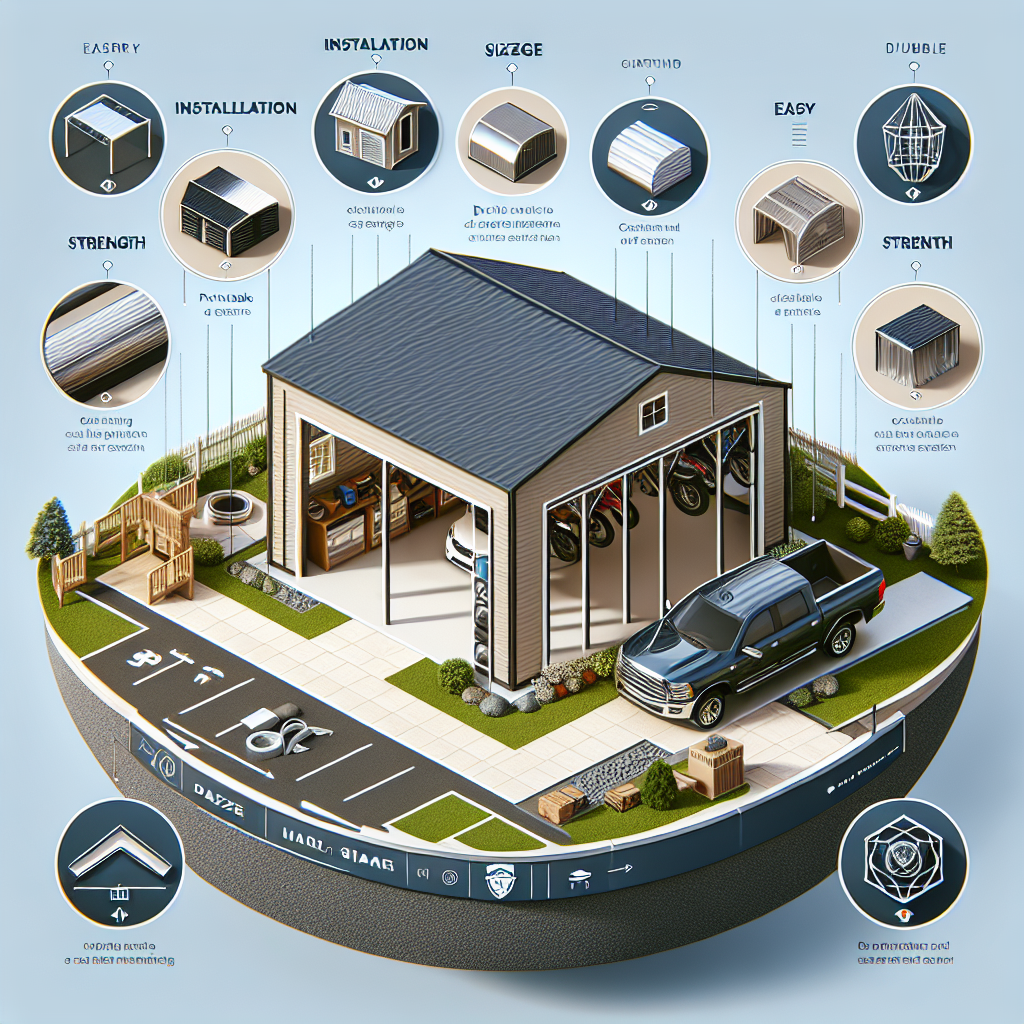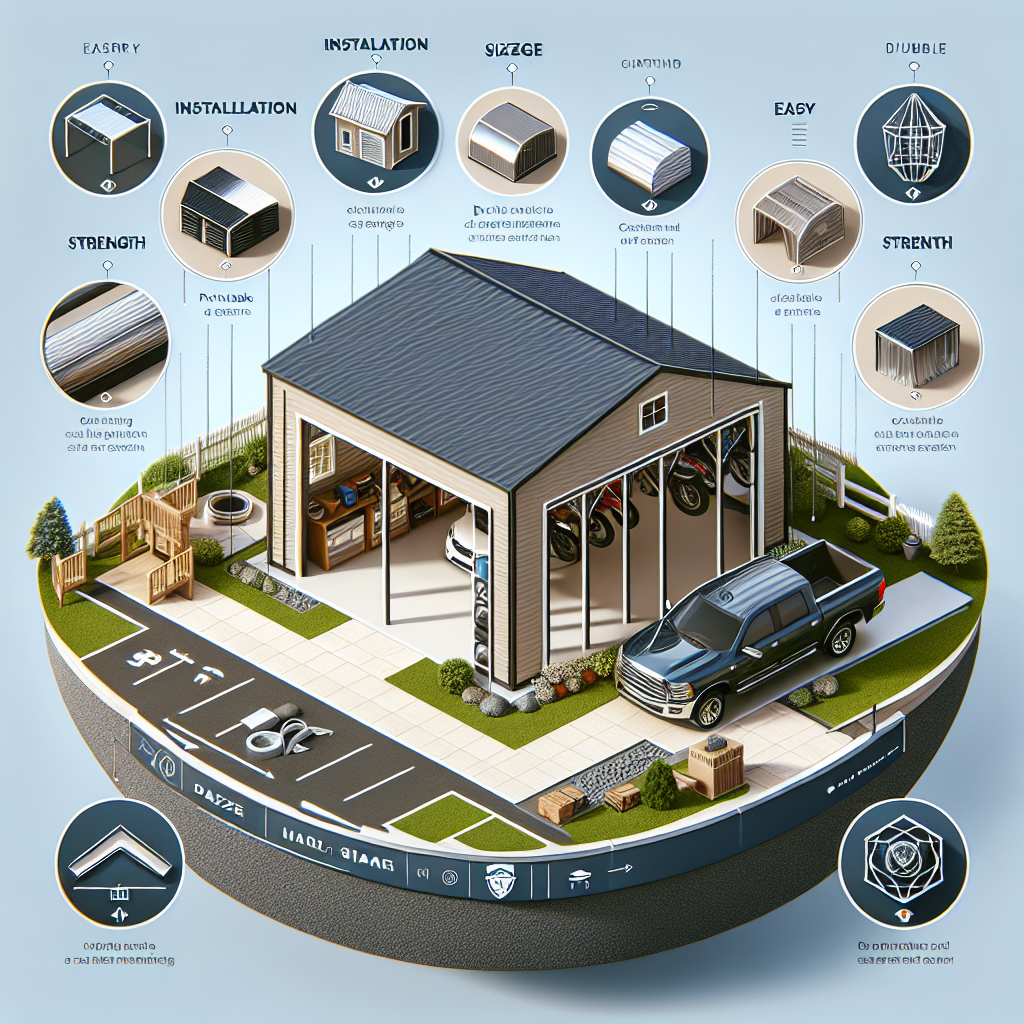If you’re in need of some extra space for your belongings or looking for a convenient shelter for your vehicle, portable garages could be the perfect solution for you. In this article, we will address some common questions about these versatile structures that will help you make an informed decision. From their durability and setup process to their versatility and weather resistance, we’ve got you covered. Get ready to learn everything you need to know about portable garages and how they can simplify your storage needs.

What is a portable garage?
Definition of a portable garage
A portable garage, also known as a temporary garage or carport, is a lightweight and easily assembled structure designed to provide shelter for vehicles, equipment, or other storage needs. Unlike traditional garages, which are permanently built and attached to a house or building, portable garages are freestanding and can be easily transported and relocated as needed.
Types of portable garages
There are various types of portable garages available on the market, catering to different needs and preferences. The most common types include:
-
Canopy-style portable garages: These garages consist of a steel frame covered by a polyethylene or polyester canopy. They are open-sided, providing easy access to vehicles or items stored inside.
-
Enclosed portable garages: These garages offer complete protection by featuring walls and a roll-up door. They are ideal for storing items that require extra security or to shield vehicles from adverse weather conditions.
-
Portable carports: Carports are similar to canopy-style portable garages, but they typically have a more compact design and are specifically designed for sheltering vehicles. They often come with a galvanized steel frame and a durable roof.
-
Heavy-duty portable garages: These garages are built to withstand harsh weather conditions and provide superior durability. They generally feature thicker frames, reinforced covers, and additional anchor points for added stability.
Benefits of using a portable garage
Portable garages offer several advantages over traditional garages or other storage solutions. Some key benefits include:
-
Mobility: The main advantage of portable garages is their ability to be easily moved and relocated. This makes them an excellent choice for individuals who frequently change residences or require temporary storage solutions.
-
Cost-effective: Portable garages are generally more affordable than building a permanent garage or renting a storage unit. They provide a cost-effective solution for individuals who need extra space for vehicles or equipment.
-
Quick and easy assembly: Portable garages can be assembled within a few hours using basic tools. They often come with user-friendly instructions and pre-drilled holes for convenient installation.
-
Versatility: These garages can be used for a variety of purposes, including vehicle storage, workshop space, outdoor events, and temporary shelter. They offer flexibility and adaptability to suit different needs.
-
Protection from the elements: Portable garages provide shelter from rain, snow, UV rays, and other harsh weather conditions. They help extend the lifespan of vehicles and protect valuable belongings.
Common uses of portable garages
Portable garages have a wide range of applications, making them a popular choice for both residential and commercial purposes. Some common uses include:
-
Vehicle storage: Portable garages offer a convenient solution for protecting cars, motorcycles, boats, RVs, and other vehicles from the elements and potential damage.
-
Outdoor events: These garages can be utilized as temporary shelter during outdoor gatherings, parties, or events, providing shade and protection for guests.
-
Workshop space: Portable garages can serve as a dedicated workspace for hobbies, DIY projects, or small businesses that require a sheltered area.
-
Equipment storage: They are also suitable for storing lawn and garden equipment, tools, construction materials, and other items that need protection from the elements.
-
Temporary living space: In certain situations, such as during home renovations or while traveling, a portable garage can be transformed into temporary living quarters or a sleeping area.
Considerations before purchasing a portable garage
Before investing in a portable garage, there are a few factors to consider to ensure it meets your specific needs:
-
Size requirements: Determine the dimensions of the garage you need based on the vehicles or equipment you plan to store. Consider both width and height to accommodate different sizes effectively.
-
Local regulations: Check with your local authorities or homeowner’s association regarding any restrictions or permits required for installing a portable garage in your area.
-
Climate and weather conditions: Consider the prevalent weather conditions in your region, such as heavy snow or strong winds. This will help you choose a portable garage with the appropriate features and materials for optimal protection.
-
Quality and durability: Look for portable garages made from high-quality materials, with sturdy frames and durable covers. This ensures longevity and reliability, especially if you plan to use the garage for extended periods or in challenging environments.
-
Budget and cost: Set a budget and explore different options within your price range. Consider the long-term savings and benefits of investing in a durable, high-quality portable garage.
How do portable garages work?
Structural components of a portable garage
Portable garages typically consist of the following major components:
-
Frame: The frame forms the skeleton of the garage and provides structural support. It is usually made of galvanized or powder-coated steel, known for its strength and resistance to corrosion. The frame is designed to be lightweight yet sturdy enough to withstand various weather conditions.
-
Cover: The cover, also referred to as the canopy or tarp, is the outer layer of the portable garage. It is made from a durable material such as polyethylene or polyester, which is UV-resistant, waterproof, and tear-resistant. The cover protects the contents of the garage from the elements and prevents damage.
-
Anchoring system: To ensure stability and prevent the garage from being blown away by strong winds, portable garages come with an anchoring system. This typically includes ground stakes or auger anchors, which are securely attached to the frame and then driven into the ground.
Installation process of a portable garage
Installing a portable garage generally involves the following steps:
-
Site preparation: Choose a suitable location for your portable garage that offers sufficient space and is level. Remove any obstacles or debris from the area to ensure a clean setup.
-
Assembly of the frame: Start by assembling the frame according to the manufacturer’s instructions. This often involves attaching different sections of the frame together using nuts, bolts, and connectors. The frame may be color-coded or labeled to simplify the assembly process.
-
Attaching the cover: Once the frame is fully assembled, lay the cover over the top and secure it to the frame using elastic cords, hook-and-loop fasteners, or bungee cords. Ensure the cover is taut and evenly distributed to prevent sagging or pooling of water.
-
Anchoring the garage: Secure the portable garage to the ground using the provided anchoring system. This typically involves driving ground stakes or auger anchors through the frame and into the ground. Ensure the anchors are firmly in place to prevent the garage from shifting or collapsing.
Maintenance and care for a portable garage
Proper maintenance and care can prolong the lifespan of your portable garage and ensure its optimal performance. Here are a few tips to keep in mind:
-
Regular cleaning: Periodically clean the cover and frame of your portable garage using a mild detergent, water, and a soft brush or cloth. This helps remove dirt, debris, and stains, preventing them from causing damage or deterioration.
-
Snow removal: If you live in an area prone to heavy snowfall, it is important to remove accumulated snow from the roof of your portable garage. Excessive weight from snow can put strain on the frame and cover, potentially causing damage or collapse.
-
Inspection and repairs: Routinely inspect the frame, cover, and anchoring system for any signs of wear, tear, or damage. Replace any damaged or worn-out parts promptly to maintain the structural integrity of the garage.
-
Proper disassembly and storage: If you need to disassemble and store your portable garage, ensure you follow the manufacturer’s instructions. Clean and dry the cover thoroughly before folding or rolling it, and store it in a dry and ventilated area to prevent mold or mildew growth.
Durability and lifespan of a portable garage
The durability and lifespan of a portable garage depend on several factors, including the quality of materials used, the frequency of use, and the environmental conditions it is exposed to. High-quality portable garages made from sturdy materials can last for several years with proper maintenance and care.
Potential issues and troubleshooting
While portable garages are generally reliable, a few issues may arise. Here are some common problems and their potential solutions:
-
Frame instability: If the frame feels shaky or unstable, ensure that the individual components are securely connected and tightened. Check that the anchoring system is properly installed and the ground stakes or auger anchors are secure.
-
Cover damage or leakage: If the cover develops tears, holes, or leaks, it can compromise the protection provided by the portable garage. Small tears can be repaired using a patch kit specifically designed for the cover material. For larger or irreparable damage, consider replacing the cover.
-
Snow accumulation: Heavy snow accumulation on the roof of the portable garage can lead to structural damage or collapse. Regularly remove snow from the cover using a snow rake or broom, avoiding the use of sharp objects that could puncture the material.
-
Mold or mildew growth: If your portable garage is exposed to high humidity or moisture, mold or mildew growth may occur on the cover. Clean the affected area with a mildew cleaner or a mixture of water and vinegar. Ensure the cover is completely dry before storing it.
What sizes are available?
Standard sizes of portable garages
Portable garages are available in a wide range of sizes to accommodate various vehicles, equipment, and storage needs. Some common standard sizes include:
-
Single car portable garages: These typically have dimensions of 10 feet wide by 20 feet long, providing enough space to shelter one car or small vehicle.
-
Double car portable garages: These are larger in size, with dimensions typically ranging from 18 feet wide by 20 feet long to 24 feet wide by 40 feet long. They can accommodate two cars or larger vehicles.
-
RV and boat portable garages: There are also larger sizes specifically designed to accommodate recreational vehicles (RVs), boats, or other oversized vehicles. These can range from 12 feet wide by 20 feet long to 24 feet wide by 40 feet long or even larger.
Customizable options for portable garages
In addition to standard sizes, many manufacturers offer customizable options for portable garages. This allows you to tailor the dimensions and features of the garage to better suit your specific needs. Customizable options may include:
-
Height adjustments: Some portable garages can be customized with increased height to accommodate taller vehicles or provide additional clearance.
-
Extended length: If you require extra storage space or need to shelter longer vehicles, some manufacturers offer the option to extend the length of the garage beyond standard sizes.
-
Additional openings: Depending on your preferences, you may be able to customize the number and placement of doors and windows to enhance accessibility and ventilation.
-
Optional accessories: Manufacturers may offer a range of optional accessories for portable garages, such as lighting fixtures, shelving units, or additional anchoring systems. These accessories can further enhance the functionality and usability of the garage.
Choosing the right size for your needs
When selecting the size of your portable garage, it is important to consider your specific needs and requirements. Here are a few factors to consider:
-
Vehicle dimensions: Measure the length, width, and height of the vehicle or equipment you intend to store in the garage. Ensure that the dimensions of the garage allow for sufficient clearance and space.
-
Future needs: Consider any potential changes or additions to your vehicle or equipment collection in the future. It is often wise to choose a slightly larger size to accommodate any future expansions.
-
Available space: Assess the available space on your property and ensure that the dimensions of the portable garage fit within the designated area. Consider any restrictions or setbacks mandated by local regulations or homeowner’s association guidelines.
-
Desired functionality: Determine the primary purpose of the portable garage and the additional features you may require. If you plan to use it as a workshop or storage space, ensure you have enough room to move around and access your items comfortably.
Remember, it is always beneficial to consult with a reputable manufacturer or retailer who can assist you in choosing the appropriate size based on your specific needs and limitations.

Are portable garages weatherproof?
Protection against rain, snow, and other elements
One of the main reasons people invest in portable garages is to protect their vehicles, equipment, or belongings from the elements. Portable garages are designed to provide effective shelter against rain, snow, and other weather conditions. The combination of a sturdy frame and a durable, waterproof cover helps prevent moisture from seeping in and damaging the contents of the garage.
Wind resistance of portable garages
While portable garages are designed to withstand moderate winds, it is important to ensure they are properly anchored to prevent damage in strong wind conditions. The anchoring system plays a crucial role in wind resistance. Ground stakes or auger anchors are typically used to secure the frame to the ground, providing stability against wind forces. In areas prone to high winds, heavy-duty or wind-rated portable garages with additional anchor points are available to provide increased resistance.
Insulation and temperature control
Portable garages may not provide the same level of insulation as permanent structures. However, the cover material and design can help regulate the temperature inside the garage to some extent. A high-quality cover with UV-resistant properties and adequate ventilation can reduce heat buildup during hot weather. In colder climates, additional insulation materials or portable heaters can be used to maintain a comfortable temperature inside the garage.
Additional weatherproofing options
To enhance the weatherproofing capabilities of a portable garage, there are some additional options to consider:
-
Rain gutters: Installing rain gutters along the edges of the garage’s roof can help channel rainwater away from the entrance and prevent water runoff near the garage.
-
Snow load supports: If you reside in an area with heavy snowfall, some portable garages offer optional snow load supports. These additional structural features help distribute the weight of accumulated snow and prevent roof collapse.
-
Ventilation options: Proper ventilation is important to prevent condensation buildup, especially in humid climates. Some portable garages come with ventilation windows or vents that can be opened or closed as needed.
-
Weather seals: Adding weather seals or sealant strips to the door openings and seams of the portable garage can help prevent drafts, water, or pests from entering the garage.
Remember, while portable garages offer protection against the elements, extreme weather conditions or natural disasters may pose challenges. It is advisable to monitor severe weather forecasts and take necessary precautions to safeguard your belongings and ensure personal safety.
Can a portable garage be secured?
Anchoring methods for portable garages
Properly securing a portable garage is essential to prevent it from being damaged or displaced by strong winds or other external forces. Anchoring methods vary depending on the type of garage and the manufacturer, but common methods include:
-
Ground stakes: Ground stakes, typically made of steel or aluminum, are driven into the ground through the frame of the portable garage. They provide stability and prevent the garage from shifting or overturning.
-
Auger anchors: Auger anchors feature a corkscrew-like design that allows them to dig into the ground more securely. They are generally considered more effective than ground stakes in areas with softer soil or higher wind speeds.
-
Concrete footings: For more permanent installations, concrete footings can be used to anchor the frame of the portable garage. This involves pouring concrete into holes dug into the ground and embedding the frame securely into the hardened concrete.
Security features to prevent theft
While portable garages are designed to provide shelter and security, there are additional security features you can consider to deter theft or unauthorized access:
-
Lockable doors: Opt for a portable garage with lockable doors or consider adding a padlock or similar locking mechanism to existing doors. This helps prevent unauthorized individuals from entering the garage or accessing valuable items stored inside.
-
Motion-activated lighting: Installing motion-activated lighting around the portable garage can help deter potential intruders and provide visibility during nighttime.
-
Security cameras: Consider installing security cameras near the entrance of the portable garage to monitor any suspicious activity. The presence of visible cameras can act as a deterrent to potential thieves.
-
Alarm systems: Some portable garages may offer optional alarm systems that can be activated to alert you in the event of unauthorized entry or tampering.
Factors to consider for enhanced security
When considering the security of your portable garage, it is important to assess the specific risks and requirements of your location. Some factors to consider include:
-
Location: Choose a well-lit and visible location for your portable garage. Avoid placing it in secluded areas, as this may attract unwanted attention or make it easier for potential thieves to go unnoticed.
-
Neighboring structures: If your portable garage is placed near existing buildings or structures, consider enhancing security measures for shared walls or connections. This prevents unauthorized access from adjacent buildings.
-
Valuables placement: Keep valuable items, such as tools or equipment, securely stored and out of sight within the portable garage. This reduces the likelihood of theft or attracting attention from potential intruders.
-
Neighborhood watch: Engage with your neighborhood watch or community group to stay informed about security concerns and collaborate with neighbors to enhance overall security.
Remember, no security measure can guarantee absolute protection against theft or vandalism. It is important to assess your individual security needs and take appropriate precautions based on your specific circumstances.
How long does it take to assemble a portable garage?
Average assembly time for different types
The time required to assemble a portable garage can vary based on factors such as its size, design complexity, and your level of experience. On average, assembly times for different types of portable garages may range as follows:
-
Canopy-style portable garages: These are typically the quickest to assemble, often taking anywhere from 1 to 3 hours, depending on the size.
-
Enclosed portable garages: With the additional steps involved in installing walls, a roll-up door, and potentially a larger frame, assembly times for enclosed portable garages can range from 3 to 8 hours.
-
Portable carports: These generally fall within the same range as canopy-style portable garages, often taking between 1 to 3 hours to assemble.
-
Heavy-duty portable garages: Due to their larger size and potentially more complex designs, heavy-duty garages can take longer to assemble, ranging from 4 to 10 hours.
Factors that can affect assembly time
Several factors can impact the time required to assemble a portable garage:
-
Experience and assistance: Familiarity with the assembly process and having someone to assist you can significantly reduce assembly time. If it is your first time assembling a portable garage, expect the process to take longer.
-
Preparation and organization: Preparing the area and organizing the components before beginning assembly can save time. Ensure you have all the necessary tools and hardware readily available.
-
Size and design complexity: Larger portable garages or those with additional features, such as windows or multiple doors, may take longer to assemble compared to smaller, simpler designs.
-
Manufacturer instructions: The clarity and comprehensiveness of the manufacturer’s instructions can impact assembly time. Clear instructions with detailed illustrations or video tutorials can expedite the process.
Tips for efficient and quick assembly
To streamline the assembly process and save time, consider the following tips:
-
Read the instructions: Read the manufacturer’s instruction manual or assembly guide thoroughly before beginning assembly. Familiarize yourself with the steps, sequence, and any special tools or techniques required.
-
Organize components: Lay out all the components and hardware in an organized manner before starting assembly. This helps prevent confusion and minimizes the time spent searching for specific parts.
-
Enlist assistance: Having someone assist you can significantly speed up the assembly process. They can help hold or stabilize certain components while you secure them in place.
-
Use powered tools cautiously: While powered tools can save time, exercise caution when using them to avoid overtightening or damaging the components. Hand tools may be more appropriate in some instances.
-
Prioritize safety: Ensure you wear the appropriate personal protective equipment, such as gloves and safety glasses, throughout the assembly process. This helps prevent injuries and allows you to work more efficiently and confidently.
Remember, the estimated assembly times provided are approximate and can vary based on individual factors. Take your time to ensure the portable garage is properly assembled, as rushing can lead to mistakes or compromised structural integrity.
Can a portable garage be relocated?
Ease of disassembly and portability
One of the standout features of portable garages is their ability to be easily disassembled and relocated. The process of disassembling a portable garage typically involves the reverse steps of assembly, focusing on removing and separating the framework and cover.
Portable garages are designed with convenience in mind, often featuring hardware such as bolts, nuts, and connectors that can be easily disengaged and reattached. Most manufacturers provide detailed instructions on disassembly, along with labeled or color-coded components to simplify the process.
Requirements for relocating a portable garage
To relocate a portable garage, the following considerations should be taken into account:
-
Transport method: Determine the most suitable method of transportation for the size and weight of the portable garage. This may involve disassembling the garage, loading it onto a suitable vehicle such as a truck or trailer, and securing it properly using straps or other restraints.
-
Site preparation: Before relocating the portable garage to a new location, ensure the new site is suitable and prepared. Clear any debris or obstacles, ensure the ground is level, and consider any local regulations or restrictions that may apply.
-
Tools and equipment: Depending on the design of the portable garage and the relocation distance, you may need specific tools or equipment to aid in disassembly, transportation, and reassembly. Ensure you have these resources readily available and familiarize yourself with their use.
-
Assistance: Relocating a portable garage, particularly larger or heavier models, often requires assistance due to the size and weight of the components. Enlist the help of others to ensure safe handling during the relocation process.
Potential challenges and considerations
While portable garages offer relative ease of relocation, there are a few challenges and considerations to keep in mind:
-
Potential damage: Improper handling or transportation methods can lead to damage of the portable garage components. Take care when disassembling, moving, and reassembling to ensure all parts remain intact and undamaged.
-
Component identification: To facilitate seamless reassembly, ensure all components are disassembled and organized in a manner that allows for easy identification and reconnection.
-
Transportation limitations: Certain types of portable garages may be more challenging to transport due to their size or weight. Consider the limitations of your chosen transportation method and consult professionals if necessary.
-
Local regulations: Be aware of any local regulations or guidelines that may require permits or impose restrictions on relocating a portable garage. Contact your local authorities or homeowner’s association to ensure compliance.
Remember, the ease of relocation for a portable garage largely depends on its design, size, and the effort put into proper disassembly, transportation, and reassembly. It is advisable to consult the manufacturer’s instructions and seek professional advice if needed.
Are permits required to install a portable garage?
Local regulations and permits
The need for permits to install a portable garage varies depending on local regulations and guidelines set by municipalities or homeowner’s associations. It is important to research and understand the specific requirements and restrictions in your area before proceeding with the installation.
Local regulations may dictate aspects such as setback distances from property boundaries or existing structures, permissible height limits, or the maximum period of time a portable garage can be installed on a property.
Applying for necessary permits
If permits are required, the process typically involves the following steps:
-
Research and consultation: Research the specific regulations and permit requirements in your area. Consult with your local planning or building department to clarify any confusion and obtain the necessary information.
-
Permit application: Once you have identified the appropriate permit, complete the required application forms. Provide accurate and detailed information about the proposed installation, including the size, location, and intended use of the portable garage.
-
Fee payment: Some permit applications may require a fee payment. Ensure you include the appropriate fees along with the application. Fees can vary depending on the location and the scope of the installation.
-
Review and approval: The permit application is typically reviewed by the relevant authorities, such as the planning or building department. They will assess the proposed installation for compliance with local regulations, including suitability of the location and adherence to applicable building codes.
-
Inspection: In some cases, a physical inspection of the portable garage installation may be required as part of the permit approval process. This ensures the installation meets safety and code requirements.
Common restrictions and guidelines
When applying for permits for a portable garage installation, be aware of the following common restrictions and guidelines:
-
Setback requirements: Local regulations may specify minimum distances that the portable garage must be set back from property boundaries or existing structures. This is to ensure safety, accessibility, and compatibility with neighboring properties.
-
Time limitations: Some areas impose time limitations on the duration for which a portable garage can be installed. Ensure you comply with any limitations, as violating these regulations may result in fines or penalties.
-
Zoning restrictions: Different zoning designations may have specific regulations regarding the installation of portable garages. Consult your local planning department to understand any applicable zoning restrictions that could affect your installation.
-
Aesthetic considerations: In certain cases, local regulations may include aesthetic guidelines to ensure the portable garage’s appearance matches the surrounding landscape or community. This could dictate factors such as color, materials, or design.
Obtaining the necessary permits for a portable garage installation helps ensure compliance with local regulations, maintains safety standards, and minimizes potential legal issues. It is advisable to contact your local authorities or homeowner’s association to obtain accurate information about specific permit requirements for your area.
Can I use a portable garage as a permanent structure?
Temporary or permanent applications
Portable garages are primarily designed for temporary or semi-permanent use. However, with proper planning and installation, a portable garage can be used as a long-term or even permanent structure in some cases.
While they may not offer the same level of durability and longevity as traditional permanent garages, portable garages have certain advantages that make them viable for permanent use. These include cost-effectiveness, flexibility, and relatively easy relocation compared to permanent structures.
Factors to consider for permanent installation
Before opting to use a portable garage as a permanent structure, consider the following factors:
-
Building codes and regulations: Ensure that a portable garage meets the local building codes and regulations for permanent structures. Some municipalities may have specific requirements, such as minimum size or foundation specifications.
-
Climate and environmental factors: Consider the climate and environmental conditions in your area. Portable garages are generally more susceptible to degradation over time due to exposure to the elements. Evaluate whether the structure can withstand local weather conditions reliably.
-
Maintenance and repairs: Portable garages used as permanent structures may require more frequent maintenance, inspections, or repairs compared to traditional permanent garages. Factor in the cost and effort involved in maintaining the structure’s integrity.
-
Future needs and flexibility: Assess your long-term plans and the potential need to relocate the garage in the future. If flexibility and portability are important considerations, a traditional permanent garage may be a better fit.
Converting a portable garage to a permanent structure
Converting a portable garage into a permanent structure requires careful planning and adherence to local regulations. Here are some considerations:
-
Foundation: Evaluate the need for a permanent foundation for the converted structure. This may involve constructing a concrete slab or foundation piers to support the weight of the garage and enhance stability. Consult with a structural engineer or contractor to ensure compliance with building codes.
-
Structural modifications: Certain structural modifications may be necessary to meet the requirements for permanent structures. This could include reinforcing the frame, adding additional supports, or upgrading the anchoring system.
-
Material upgrades: Assess the materials used in the portable garage and consider upgrading them to enhance durability and longevity. Reinforced covers, thicker frame components, or weather-resistant coatings can be considered to improve performance.
-
Permits and inspections: Check with local authorities to determine if permits are required for converting a portable garage into a permanent structure. Be prepared for inspections during and after the conversion process to ensure compliance with building codes.
It is crucial to consult with professionals, such as contractors, engineers, or architects, to ensure a successful conversion from a portable garage to a permanent structure. They can provide expert advice, assess feasibility, and guide you through the necessary steps to meet local regulations and achieve a safe and functional result.
Where can I purchase a portable garage?
Local stores and retailers
Portable garages are available at a wide range of local stores and retailers. Consider visiting the following types of establishments to find portable garages:
-
Home improvement stores: Major home improvement chains often carry a variety of portable garages. Visit your local store to explore different options and assess the quality and features of the available models.
-
Outdoor and camping stores: Some outdoor or camping specialty stores may offer portable garages designed for recreational use. These stores can be a good option for smaller, more compact models.
-
Farm and agricultural supply stores: Farm supply stores typically have a selection of portable garages suited for agricultural purposes, such as protecting farm equipment or storing hay.
Online marketplaces and websites
Online platforms and websites provide a convenient and extensive selection of portable garages. Consider the following options for purchasing a portable garage online:
-
Manufacturer websites: Visit the websites of reputable manufacturers that specialize in portable garages. These websites often provide detailed product information, specifications, and options for customization.
-
Online marketplace platforms: Popular online marketplaces, such as Amazon, eBay, and Walmart, offer a wide range of portable garages from various manufacturers and sellers. These platforms allow you to compare prices, read customer reviews and ratings, and make informed purchasing decisions.
-
Specialty retailers: Explore websites of retailers specializing in outdoor storage solutions or portable shelters. These retailers often offer an extensive selection of portable garages, along with accessories and additional information on assembly and maintenance.
Considerations when buying online
When purchasing a portable garage online, keep the following considerations in mind:
-
Product reviews and ratings: Read customer reviews and ratings to gain insight into the quality and performance of the portable garage you are considering. Pay attention to any recurring issues or positive feedback regarding assembly, durability, or customer service.
-
Shipping and delivery: Confirm shipping costs and delivery times before making a purchase. Portable garages are typically large and heavy, so be prepared for potentially higher shipping costs or longer delivery times.
-
Warranty and return policy: Review the manufacturer’s warranty and the seller’s return policy to understand what coverage is provided in case of defects, damages, or dissatisfaction with the product.
-
Customer service and support: Consider the availability and responsiveness of customer service and technical support provided by the manufacturer or seller. Reliable customer support can be beneficial in case you require assistance during the assembly process or have any post-purchase concerns or inquiries.
Before making a final decision, compare prices, features, and the reputation of the manufacturer or seller. Take the time to research and read product details and reviews extensively to ensure you choose a portable garage that meets your specific needs and requirements.







